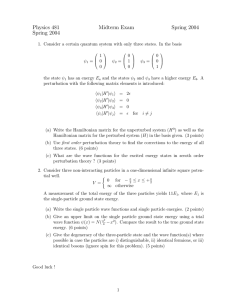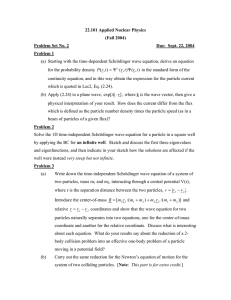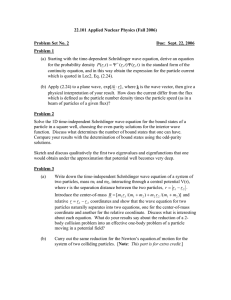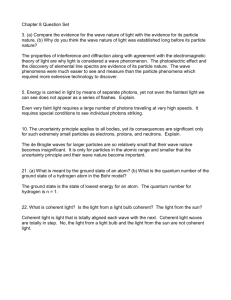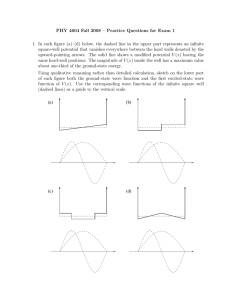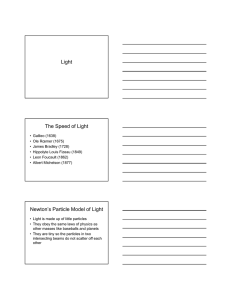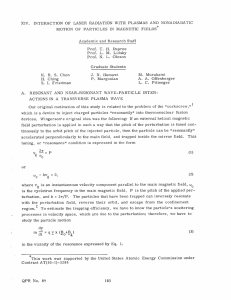Lesson 18
advertisement
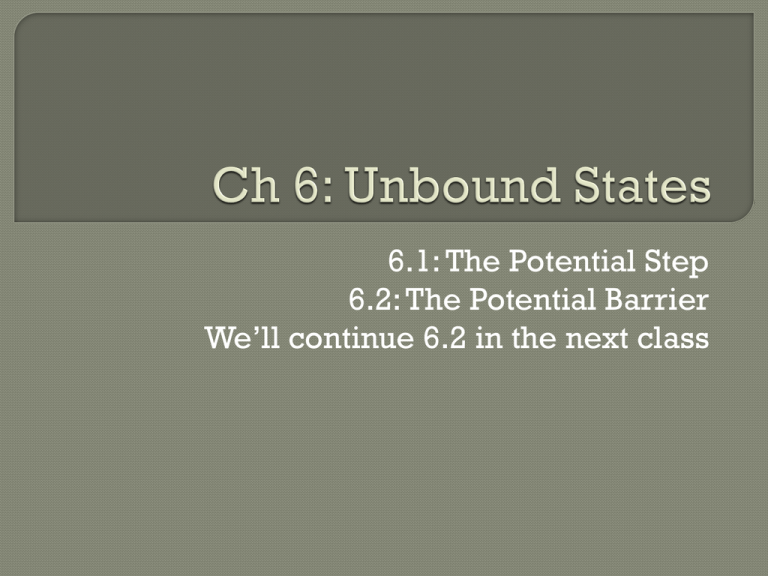
6.1: The Potential Step 6.2: The Potential Barrier We’ll continue 6.2 in the next class Plane wave solutions Right-moving: Ψ 𝑥𝑥, 𝑡𝑡 = 𝐴𝐴𝐴𝐴 +𝑖𝑖(𝑘𝑘𝑘𝑘−𝜔𝜔𝑡𝑡) =𝐴𝐴𝐴𝐴 +𝑖𝑖𝑖𝑖𝑖𝑖−𝑖𝑖𝜔𝜔𝑡𝑡 Left-moving: Ψ 𝑥𝑥, 𝑡𝑡 = 𝐴𝐴𝐴𝐴 −𝑖𝑖𝑖𝑖𝑖𝑖−𝑖𝑖𝜔𝜔𝑡𝑡 −𝑖𝑖𝜔𝜔𝑡𝑡 Time solution is the same 𝜙𝜙 𝑡𝑡 = 𝑒𝑒 We’ll focus on the space parts: +𝑖𝑖𝑖𝑖𝑖𝑖 Right-moving: 𝜓𝜓 𝑥𝑥 = 𝐴𝐴𝐴𝐴 −𝑖𝑖𝑖𝑖𝑖𝑖 Left-moving: 𝜓𝜓 𝑥𝑥 = 𝐴𝐴𝐴𝐴 In general A may be complex We are really considering a beam of traveling particles. So the amplitude A*A represents the number of particles per unit distance. Review ℏ2 𝜕𝜕2 𝜓𝜓 𝑥𝑥 Time indep. Schrodinger: − 2𝑚𝑚 𝜕𝜕𝜕𝜕 2 ℏ2 𝜕𝜕2 𝜓𝜓 𝑥𝑥 When U = 0: − = 𝐸𝐸𝜓𝜓 𝑥𝑥 2𝑚𝑚 𝜕𝜕𝜕𝜕 2 2 𝜕𝜕 𝜓𝜓 𝑥𝑥 Rearrange: = −𝑘𝑘 2 𝜓𝜓 𝑥𝑥 where 2 𝜕𝜕𝜕𝜕 + 𝑈𝑈 𝑥𝑥 𝜓𝜓 𝑥𝑥 = 𝐸𝐸𝜓𝜓 𝑥𝑥 𝑘𝑘 2 = 2𝑚𝑚𝑚𝑚 ℏ2 All four functions--sin (kx), cos (kx), e+ikx and e-ikx -are solutions. For bound states we used sines and cosines to describe standing waves. We could have used complex exponential functions, but that would have been an unnecessary complication. Now we need to describe waves travelling to the right or left and we must use complex exponential functions. Potential is zero to the left (x < 0). Particle is free in this region. The free particle encounters a potential step (at x = 0)— steep increase in potential energy due to a charged, narrow capacitor. The potential energy is a nonzero constant U0 for x > 0. 𝑑𝑑𝑑𝑑 Remember 𝐹𝐹 = − , a force to 𝑑𝑑𝑑𝑑 the left. If E > U0, according to classical physics, the particle continues moving rightward with a less kinetic energy (moves slower). However if the potential jumps abruptly in an region that is small compared to the wavelength of the particle, then we must model the particle as a wave and apply quantum mechanics. According to quantum mechanics, when a right moving wave encounters the potential step, it may be transmitted, but it also may be reflected. (much like light encountering a boundary between two media.) It does NOT matter if there is a step up or a step down. Let’s find probability of reflection and transmission. (be patient) • For x < 𝜕𝜕2 𝜓𝜓 𝑥𝑥 0: 𝜕𝜕𝜕𝜕 2 2 2 = −𝑘𝑘 𝜓𝜓 𝑥𝑥 where 𝑘𝑘 = 2𝑚𝑚𝑚𝑚 ℏ2 −𝑖𝑖𝑖𝑖𝑖𝑖 And the solution is 𝜓𝜓𝑥𝑥<0 𝑥𝑥 = 𝐴𝐴𝐴𝐴 +𝑖𝑖𝑖𝑖𝑖𝑖 +𝐵𝐵𝐵𝐵 ℏ2 𝜕𝜕2 𝜓𝜓 𝑥𝑥 • For x >0: − + 𝑈𝑈0 𝜓𝜓 𝑥𝑥 = 𝐸𝐸𝜓𝜓 𝑥𝑥 2𝑚𝑚 𝜕𝜕𝜕𝜕 2 𝜕𝜕2 𝜓𝜓 𝑥𝑥 2𝑚𝑚(𝐸𝐸−𝑈𝑈0 ) 2 ′ 2 ′ • = −𝑘𝑘 𝜓𝜓 𝑥𝑥 where 𝑘𝑘 = 𝜕𝜕𝜕𝜕 2 ℏ2 • Mathematically the solution is the sum of • rightward and leftward travelling waves, but there is nothing to cause the wave to travel leftward in this region. So we reject the leftward solution. ′ +𝑖𝑖𝑖𝑖 The physical solution is 𝜓𝜓𝑥𝑥>0 𝑥𝑥 = 𝐶𝐶𝑒𝑒 𝑥𝑥 𝜓𝜓𝑥𝑥<0 𝑥𝑥 = 𝐴𝐴𝐴𝐴 +𝑖𝑖𝑖𝑖𝑖𝑖 +𝐵𝐵𝐵𝐵 −𝑖𝑖𝑖𝑖𝑖𝑖 Reflected Incident 𝜓𝜓𝑥𝑥>0 𝑥𝑥 = ′ +𝑖𝑖𝑖𝑖 𝐶𝐶𝐶𝐶 𝑥𝑥 Transmitted Number of incident particles (per unit distance): 𝜓𝜓 2𝑖𝑖𝑖𝑖𝑖𝑖 = 𝐴𝐴∗ 𝐴𝐴 Number of reflected particles (per unit distance): 𝜓𝜓 2𝑟𝑟𝑟𝑟𝑟𝑟𝑟𝑟 = 𝐵𝐵 ∗ 𝐵𝐵 Number of transmitted particles (per unit distance): 𝜓𝜓 2𝑡𝑡𝑡𝑡𝑡𝑡𝑡𝑡𝑡𝑡 = 𝐶𝐶 ∗ 𝐶𝐶 Apply and boundary conditions: 2𝑘𝑘 𝐶𝐶 = 𝐴𝐴 𝑘𝑘 + 𝑘𝑘𝑘 𝑘𝑘 − 𝑘𝑘𝑘 𝐵𝐵 = 𝐴𝐴 𝑘𝑘 + 𝑘𝑘𝑘 Transmission Probability: 𝐸𝐸(𝐸𝐸 − 𝑈𝑈0 ) 4𝑘𝑘𝑘𝑘𝑘 𝑇𝑇 = =4 ′ 2 (𝑘𝑘 + 𝑘𝑘 ) [ 𝐸𝐸 + (𝐸𝐸 − 𝑈𝑈0 )]2 And reflection probability 𝑘𝑘 − 𝑘𝑘𝑘 𝑅𝑅 = 𝑘𝑘 + 𝑘𝑘𝑘 2 = 𝐸𝐸 − (𝐸𝐸 − 𝑈𝑈0 ) 𝐸𝐸 + (𝐸𝐸 − 𝑈𝑈0 ) 2 Ch 6: 14, 15 Reflected Incident 𝜓𝜓𝑥𝑥<0 • For x • 𝑥𝑥 = 𝐴𝐴𝐴𝐴 +𝑖𝑖𝑖𝑖𝑖𝑖 +𝐵𝐵𝐵𝐵 −𝑖𝑖𝑖𝑖𝑖𝑖 𝜕𝜕2 𝜓𝜓 𝑥𝑥 >0: 𝜕𝜕𝜕𝜕 2 = +𝛼𝛼 2 𝜓𝜓 𝑥𝑥 2 where 𝛼𝛼 = 2𝑚𝑚(𝑈𝑈0 −𝐸𝐸) ℏ2 𝑥𝑥 = 𝐶𝐶𝐶𝐶 −𝛼𝛼𝑥𝑥 +𝐷𝐷𝑒𝑒 +𝛼𝛼𝛼𝛼 But D = 0 otherwise wave function diverges. 𝜓𝜓𝑥𝑥>0 Apply And And boundary conditions: 𝐴𝐴 + 𝐵𝐵 = 𝐶𝐶 𝑖𝑖𝑘𝑘 𝐴𝐴 − 𝐵𝐵 = −𝛼𝛼𝛼𝛼 𝛼𝛼 + 𝑖𝑖𝑖𝑖 𝐵𝐵 = − 𝐴𝐴 𝛼𝛼 − 𝑖𝑖𝑖𝑖 |B| = |A| Reflection probability: R = 1. So transmission probability is zero. Wave reflects completely, but there is some nonzero probability it is to the right of the step. Penetration depth is the same as before: 1 ℏ 𝛿𝛿 ≡ = 𝛼𝛼 2𝑚𝑚(𝑈𝑈0 − 𝐸𝐸) Ch So 6: 17 Ch 6: 14, 15 and 17 are due on Tuesday 24NOV (just before Tday break) 𝜓𝜓𝑥𝑥<0 𝑥𝑥 = 𝐴𝐴𝐴𝐴 +𝑖𝑖𝑖𝑖𝑖𝑖 +𝐵𝐵𝐵𝐵 −𝑖𝑖𝑖𝑖𝑖𝑖 𝜓𝜓0<𝑥𝑥<𝐿𝐿 𝑥𝑥 = 𝐶𝐶𝑒𝑒 +𝑖𝑖𝑖𝑖′𝑥𝑥 +𝐷𝐷𝑒𝑒 −𝑖𝑖𝑖𝑖′𝑥𝑥 𝜓𝜓𝑥𝑥>𝐿𝐿 𝑥𝑥 = 𝐹𝐹𝑒𝑒 +𝑖𝑖𝑖𝑖𝑖𝑖 Reflection Resonant Or and transmission probabilities: Transmission, when R = 0: 2𝑚𝑚(𝐸𝐸 − 𝑈𝑈0 ) 𝐿𝐿 = 𝑛𝑛𝜋𝜋 ℏ 1 𝑛𝑛𝑛𝑛𝑛 𝐸𝐸 = 𝑈𝑈0 + 2𝑚𝑚 𝐿𝐿 2
